M. D. Baldwin, U.S. Indian Agent for the Blackfeet Agency, replies in response to an Office of Indian Affairs letter that he can obtain 14 students for the Carlisle Indian School. He further requests to be able to send one of the student's parents as an escort. Baldwin ends by asking to be advised on traveling and incidental expenses.
Letters/Correspondence
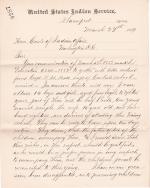
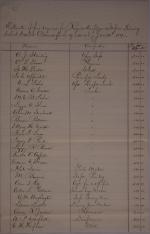
Estimate of funds for the fourth quarter of 1889 amounting to $10,931.80 for support of the school. Richard H. Pratt also requests additional funds amounting to $7,795.00 for regular employee pay. There are also math equations relating to the amount of money that Pratt has on hand and an unpaid beef account.
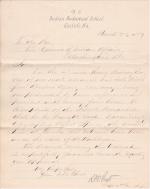
Richard Henry Pratt forwards account covering the expense of returning Henry Standing Bear and requests approval.
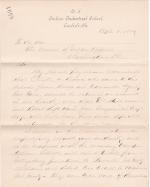
Richard Henry Pratt requests permission to return Elliott, William Short Nose, and Robert Left Hand to their homes due to their ill health. Pratt further requests transportation to various locations for the three students.
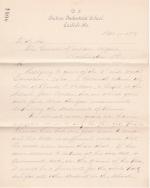
Richard Henry Pratt returns a letter from Thomas A. Metoxen who had requested to be returned home. Pratt also encloses an endorsement from Marianna Burgess disputing his statement. Pratt further states that it has been the policy of Carlisle to only accept students on a five year term and that Metoxen only has one more year left on his…
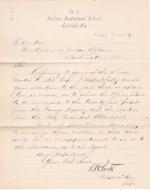
Richard Henry Pratt requests from the Office of Indian Affairs information on what the Office desires for the 25 pupils from the Navajo Agency and the parties from the Nez Perce and Blackfeet Agencies.
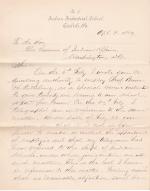
Richard Henry Pratt requests action in employing Professor Brown for 20 music lessons.
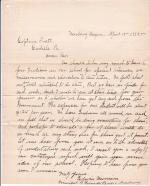
Richard Henry Pratt forwards a letter from Edwin Morrison, Principal of the Friends Pacific Academy in Newberg, Oregon, in regards to enrolling Indian students at his school.
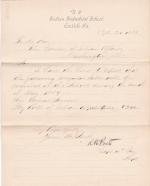
Captain Richard H. Pratt provides the Commissioner of Indian Affairs with a list of irregular labor required for May 1889. Pratt also includes details on compensation, position title, and the number of workdays required for the month.
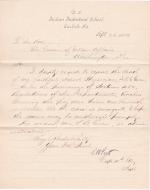
Notice of the death of Obadiah G. Given, School Physician. Richard Henry Pratt forwards vouchers covering the pay due him to be paid out to his estate.
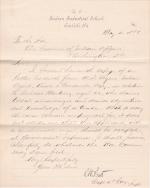
Richard Henry Pratt forwards request of Lone Star through the Kiowa, Comanche and Wichita Agent for the enrollment of an adopted member of the Kiowa Nation. The letter states that the proposed student was captured as a child in New Mexico.
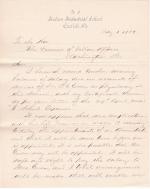
Richard Henry Pratt forwards vouchers covering the balance of salary due Obadiah G. Given. Pratt requests authority to pay the salary to Given's wife rather than his estate.
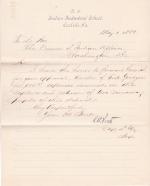
Richard Henry Pratt submits a voucher from Fisk Goodyear resulting from expenses incurred from the capture and return of two runaway students.
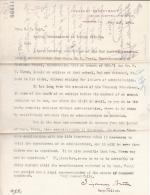
Sigourney Butler, Comptroller, informs R. V. Belt that the remaining pay due to Obadiah G. Given should be delayed until a legal representative is appointed to handle the estate.
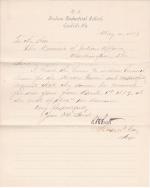
Richard Henry Pratt forwards the lease for the Hocker Farm and requests that the lease be renewed for one year starting April 1, 1889 for $600.
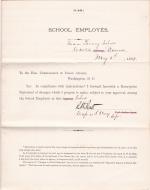
Richard Henry Pratt submits a report that lists a new employee (Carrie E. Morse). This report includes personal information about those being hired. In a cover letter, Pratt explains the process in which Morse was appointed as a teacher at the Carlisle Indian School and her transfer to the Normal School at Englewood, Illinois.
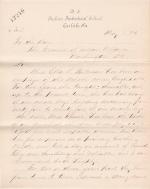
Richard Henry Pratt forwards a request from Ella and Bessie Patterson to be transferred to the Albuquerque Indian School. Pratt provides the employment history of the Pattersons' at the Carlisle Indian School and recommends their request be granted.
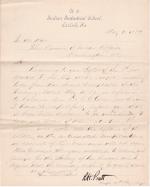
R. V. Belt, Acting Commissioner of Indian Affairs, forwards the letter of Richard Henry Pratt regarding his request to pay Obadiah G. Given's wife as there is no longer a need for letters of administration in his estate.
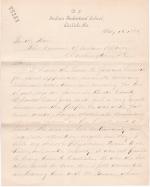
Richard Henry Pratt forwards accounts covering medical care for two students who are on outing in farms in Bucks County, Pennsylvania for approval by the Office of Indian Affairs. Pratt notes that Charles Carr was unable to be transported back to the school and so was cared for at his outing home. Pratt ends by claiming that it is general habit…
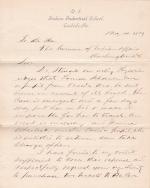
Richard Henry Pratt requests to return Louise Schanandore (here Louisa Schanandore) on the advice of the acting physician due to ill health. Pratt notes that she can be escorted by Jemima Wheelock whose term of enrollment has ended.
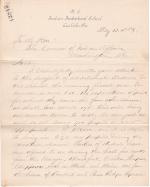
Richard Henry Pratt requests authority to bring in an additional 275 students from various agencies for the upcoming fiscal year. Pratt notes that the school currently has 611 students, but he expects to lose about 175 due to expiration of enrollment terms. Further he states that he was in negotiation to bring in students from various agencies…
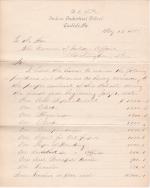
Richard Henry Pratt provides a list of positions and salaries necessary for the function of the school. Pratt notes the changes in positions including eliminating the position of principal teacher due to his taking more direct charge of the school.
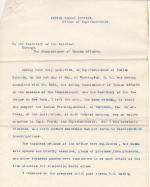
Daniel Dorchester, Superintendent of Indian Schools, reports on his surprise visit and inspection of the Carlisle Indian School. Dorchester provides an overview of his visit including his visit to all of the school rooms noting the various levels of education in each subject evinced by the students. Dorchester provides a highly favorable report…
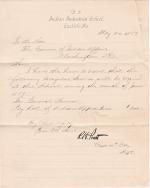
Captain Richard H. Pratt provides the Commissioner of Indian Affairs with a list of irregular labor required for June 1889. Pratt also includes details on compensation, position title, and the number of workdays required for the month.
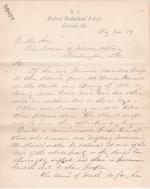
Richard Henry Pratt provides an update on the Apache prisoners brought from the Mount Vernon Barracks in the winter and spring of 1886-1887. Pratt notes that of the 106 students, 27 have died and two others will likely die within a few days. Pratt describes the generally downward trend of the party of students and requests to return the party…
